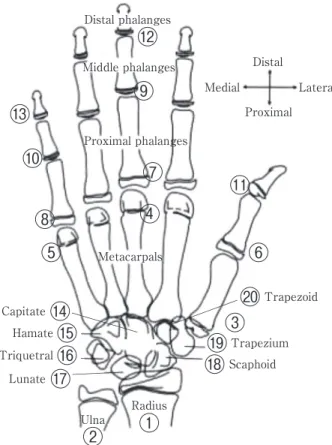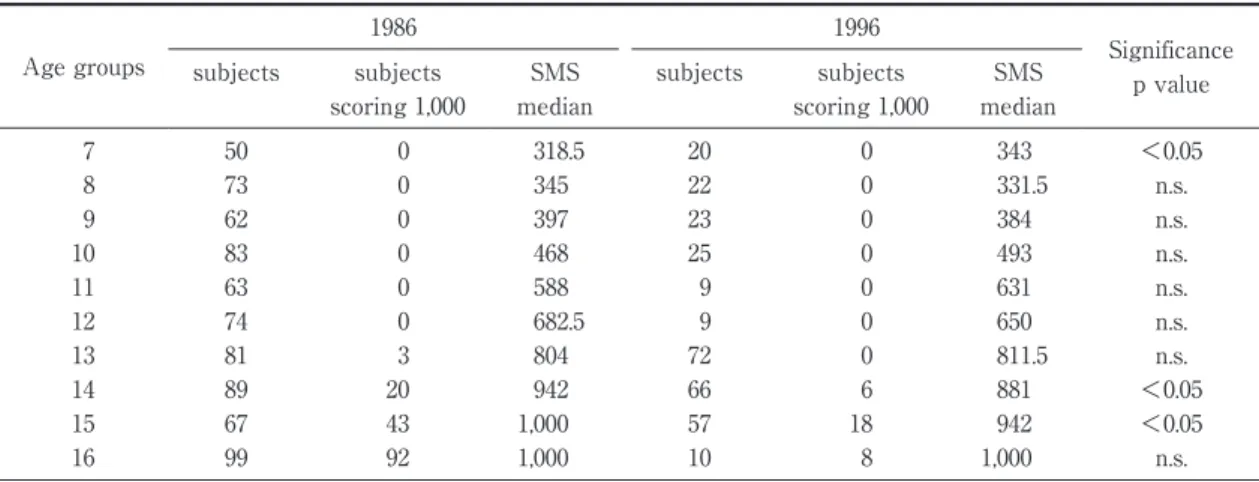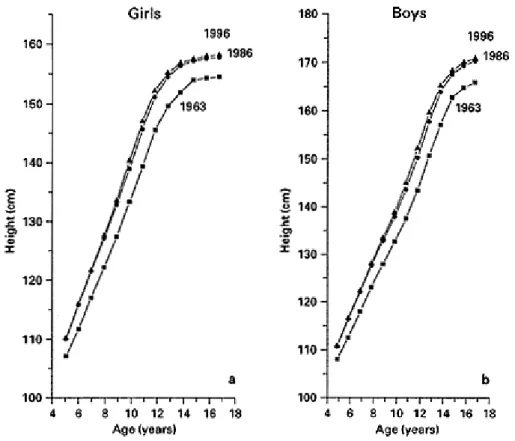総 説
Tanner-Whitehouse 2 法骨成熟スコアによる生物学的発達の評価
東京女子医科大学東医療センター小児科 マツオカ ヒサフミ 松岡 尚史 (受理 平成 29 年 1 月 23 日)Biological Development Based on Skeletal Maturity Score as Assessed Using the Tanner-Whitehouse 2 Method Hisafumi MATSUOKA
Department of Pediatrics, Tokyo Women s Medical University Medical Center East
The association between secular trends in height and changes in bone maturation was investigated. The first group of subjects consisted of a total of 1,057 girls and 1,055 boys who participated in a health research project conducted in Japan and China in 1986. The second group of subjects consisted of a total of 382 girls and 629 boys who participated in a research project examining bone mineral density in 1996. The skeletal maturity score was assessed using the Tanner-Whitehouse 2 RUS method. The Wilcoxon rank sum test was then applied to examine the significance of the differences between the 1986 and the 1996 groups. The 1996 children had not matured more quickly than the 1986 children, and the children in both groups reached the given scores at almost the same ages. In girls, there was a small difference between the groups at 7 years of age, but this difference decreased from the age of 8 years onwards. Some apparent differences arose at ages 14 and 15 years, but these differences ceased by the age of 16 years in girls. No differences were found for boys between the ages of 7 and 17 years, ex-cept for 12-year-olds. We did not detect a notable difference in bone maturation between the 1986 and 1996 groups of children, and no differences in height were observed during the same period. Our findings suggest that bone maturation reflects the secular trend in growth.
Key Words: Tanner-Whitehouse 2 method, bone age, secular trend, biological development, skeletal maturation
はじめに 小児の発育を考える際,ヒトの生物学的な骨成熟 度を示す骨年齢は発達年齢のひとつとして重要なも のである.1895 年に Roentgen が X 線を発見した直 後の 1896 年には,Rowland が 7 歳女児の骨成熟を 観察したと言われるが,1937 年に Todd が手首を含 めた手の骨の X 線図譜を作成したのが臨床応用の 始めである.その後,手骨を対象とした骨年齢の概 念が導入され,視察的方法(アトラス法,図譜式の 査定法)の 1 つである Greulich & Pyle 法(GP 法)1) が 1959 年に作成され,小児科領域では日常診療に多 く使われてきた.対象者の左手手部・手根骨の X 線画像より,その骨の成熟度(骨化や骨幹と骨端の 癒合化)を評価するものであるが,同法は,規格 X 線写真図(アトラス,基準図)と対象者の X 線写真 図を対照観察し,最も類似した基準図に代表される 骨年齢を読み取る方法である.これは簡便ではある が化骨の形がアトラスとちがった場合や化骨順序が 異なると判定が難しい.また客観性にも乏しいとい う欠点がある. 1962 年,もう少し柔軟性があり,より数学的にき め細やかな基盤からできた骨成熟の評価法が考案さ れた.つまり,GP 法の欠点を補い,骨成熟度の評価 も併せて可能とするものとして開発されたのが,骨 :松岡尚史 〒116―8567 東京都荒川区西尾久 2―1―10 東京女子医科大学東医療センター小児科 Email: matsuoka.hisafumi@twmu.ac.jp ! # $ 東女医大誌 第 87 巻 臨時増刊 1 号 頁 E48∼E53 平成 29 年 5 月 " # %
Fig. 1 Evaluation parts of the left hand and wrist based on Tanner-Whitehouse 2 Method
①∼⑬ : RUS method, ⑭∼⑳ : CARPAL method.
②
③
④
⑤
⑥
⑦
⑧
⑨
⑩
⑪
⑫
⑬
⑮
⑯
⑱
⑲
⑳
①
Distal Medial Proximal Distal phalanges Middle phalanges Proximal phalanges Metacarpals Hamate⑭
Capitate Triquetral⑰
Lunate Ulna Radius Scaphoid Trapezium Trapezoid Lateral 評 点 法(ス コ ア 法)の 1 つ で あ る Tanner-Whitehouse 法(いわゆる TW1 法)である.具体的 には,手首を含めた手の骨についてそれぞれを個々 に 8∼9 段階の発育段階に分け,各ステージに点数を 与えてあり,各スコアの合計点で骨年齢を判定する ものである.その改訂版である TW2 法2) が 1983 年 に出版されたが,そこでは狭義での 7 つの手根骨の 成熟度と橈骨,尺骨,短骨など長管骨の成熟度の評 価が別々になされ,また男女別に評価できることで 最終身長予測にも応用可能となった.Phyllis B. Ev-eleth ら の 編 集 し た「World Wide Variation in Hu-man Growth 2nd ed」(Cambridge University Press, 1990)によれば,TW2 法が小児の骨成熟評価法の国 際的な標準となっている. TW2 法による骨成熟段階の算出方法 手部 Xp から骨年齢を算出する場合,人類学での 約束事として変異が少ないという理由から左手を対 象とする. 1.評価対象 橈骨,尺骨,第 1・3・5 指の中手骨,第 1・3・5 指の基節骨,第 3・5 指の中節骨,第 1・3・5 指の末 節骨の計 13 個の長管骨【RUS 骨年齢】(Fig. 1①∼ ⑬). 有頭骨,有鉤骨,舟状骨,三角骨,月状骨,大菱 形骨,小菱形骨の計 7 個の手根骨【CARPAL 骨年 齢】(Fig. 1⑭∼⑳). また,RUS と CARPAL 合計 20 個の骨から算出 するものを 20BONE 骨年齢とする. 2.総骨成熟スコア算出 RUS については骨幹と骨端の癒合化段階を A∼ H(I)で割り当てる.CARPAL については骨化に着 目して A∼H(I)段階を決定する.A∼H(I)各段 階にはスコアが決められていて,RUS では 13 個の スコアを合計し,CARPAL では 7 個のスコア,20 BONE では 20 個のスコアを合計する.各合計スコ アは,それぞれ 0(骨核が見えない)から 1,000(完 熟)までとなる.各骨の A∼H(I)段階評価方法は 男女共通であるが,各段階に対応するスコアは骨年 齢別男女別で異なる. 3.骨年齢算出 各性別各骨年齢別概算表を用いて,合計スコア(総 骨成熟スコア)に対応する骨年齢を,RUS,CAR-PAL,20BONE ごとで決定する.TW2 法原法骨年齢算出対象者の背景 全例,1960 年代の英国で社会・経済水準が平均的 な家庭の子弟から選出された.以下で示す 7 つの地 域集団から,3∼16 歳の横断的調査から収集された 約 2,200 枚の手部 Xp 写真と,1∼21 歳まで縦断的に 調べられた 5,500 枚の Xp 写真が TW2 法の段階評 価に沿って読影され骨成熟スコア算出対象となっ た. 1)London:1952∼1972 年,1∼18 歳,男 児 100 人,女児 100 人,縦断的データ 2)Harpenden:1950∼1970 年,5∼21 歳,男児 52 人,女児 105 人,縦断的データ 3)Oxford:1946∼1953 年,1∼5 歳,男児 109 人,女児 105 人,縦断的データ 4)Ayr:1956 年,3∼14 歳,男児 462 人,女児 444 人,横断的データ 5)Kilmarnock:1956 年,3∼13 歳,男児 450 人, 女児 470 人,横断的データ 6)Ganges:1960 年,15∼16 歳,男児 212 人,横 断的データ 7)Mayfield:1960 年,14∼16 歳,女児 139 人,横 断的データ 日本人骨年齢算出対象者の背景 生物学的年齢には,歯牙年齢,第二次性徴年齢, プロポーション年齢などがあるが,より客観的な評 価法は骨年齢である.しかしながらこの骨年齢にお いても人種,社会・経済水準,地域,世代での差が 生じることは想定しやすい.この仮定に基づき,同 一人種,同一地域,同一階層での世代間の骨成熟過 程を比較した. 1.1986 年グループ 日中共同研究3) の一環として日本体育協会スポー ツ科学委員会が 1986 年 4 月 1 日から 7 月 15 日まで の間に撮影した関東地方の小学校,中学校,高等学 校に在籍する児童,生徒の左手部 X 線フィルムであ る.標準的な骨成熟を明らかにすることを目的とし ているため,各暦年齢グループにおける身長,体重 が±1 SD の範疇にはいる男子 543 人,女子 532 人で ある. 2.1996 年グループ 日本学校保健会による“健常小児の骨密度測定”4) のため,東京巣鴨のスポーツスクール所属の 7 歳か ら 17 歳となった男子 629 人,女子 382 人を対象とし て, 左手部 X 線フィルム撮影と身体計測を行った. 種目としては水泳,体操,サッカー,テニス,キッ ズビクス,ゴルフ,武道(剣道,空手道,柔道)を 行う健常児のみである. 日本人 TW2RUS 骨成熟スコアの世代間の比較 TW2 法の骨年齢評価 RUS,CARPAL,20BONE の 3 法のうち,RUS のみが最終身長予測をする上 で,有意な相関を認める.CARPAL は男女とも早期 に完熟してしまい思春期以降の骨年齢判定には無効 である.このため,骨成熟を世代間で比較する場合 には,共通指標として RUS 骨成熟スコアが適切で ある.Table 1,2 は各性別暦年齢別 RUS 骨成熟ス コアの中央値を示し,1986 年と 1996 年との各スコ ア間の有意差検定(Wilcoxon rank sum test)の結果 を併記している.年長児については,骨年齢完熟つ まりスコア 1,000 点に到達した人数についても提示 している. 女子では,暦年齢 7 歳,14 歳,15 歳で 1986 年東 京グループが高値である.7∼13 歳までは参考まで に表示したイギリス基準(1963)よりやや遅めに, 1986 年東京と 1996 年東京とも同じテンポで増加し ている.13 歳以降では 両 者 と も に イ ギ リ ス 基 準 (1963)よりも急速に早熟化がみられ,14 歳,15 歳 では 1986 年東京が有意に早熟であるものの,16 歳 時には Skeletal Maturity Score(SMS)スコアと完熟 者数に有意差はない(Fig. 2a). 男子では,骨成熟スコアの有意差は暦年齢 12 歳グ ループのみで 1986 年東京グループの高値がみられ る.7∼12 歳まではイギリス基準(1963)にそって, 1986 年東京と 1996 年東京とも同じテンポで増加し ている.12∼14 歳では両者ともにイギリス基準より も急速に早熟化がみられ,14 歳以降は 1986 年東京 がやや加速傾向を示すものの SMS スコアと完熟者 数に有意差はない(Fig. 2b). 日本人小児における身長成長曲線と TW2RUS 骨成熟スコア 文部科学省による学校保健統計調査報告書5) の データを基に作成した 1963 年,1986 年,1996 年の 各年齢標準値から作成した男女別身長成長曲線を Fig. 3 に提示した.1963 年から 1986 年への比較で は,明らかな身長増加傾向がすべての暦年齢群で確 認でき,世代間格差の存在がうかがえる.つまり, 年代経過とともに日本人小児は高身長化しているこ とが確認できる.しかし,1986 年と 1996 年には男女 とも全世代において身長差がみられず,日本人小児 の高身長化の傾向は収束している. 実際,1945 年の第 2 次世界大戦終結以降,日本小
Fig. 2 Comparison of TW2-RUS SMS distance curves between 1986 and 1996 groups in girls (a) and boys (b) (dotted
line shows RUS SMS Curve for the 1963 children which was converted from TW2 20 bone scores). SMS: skeletal ma-turity score.
Table 1 Skeletal Maturity Score based on TW2 RUS method: girls
Age groups
1986 1996
Significance p value subjects subjects SMS subjects subjects SMS
scoring 1,000 median scoring 1,000 median
7 50 0 318.5 20 0 343 <0.05 8 73 0 345 22 0 331.5 n.s. 9 62 0 397 23 0 384 n.s. 10 83 0 468 25 0 493 n.s. 11 63 0 588 9 0 631 n.s. 12 74 0 682.5 9 0 650 n.s. 13 81 3 804 72 0 811.5 n.s. 14 89 20 942 66 6 881 <0.05 15 67 43 1,000 57 18 942 <0.05 16 99 92 1,000 10 8 1,000 n.s. n.s=No significance, SMS=Skeletal Maturity Score.
Table 2 Skeletal Maturity Score based on TW2 RUS method: boys
Age groups
1986 1996
Significance p value subjects subjects SMS subjects subjects SMS
scoring 1,000 median scoring 1,000 median
7 46 0 212.5 101 0 202 n.s. 8 81 0 228 86 0 224 n.s. 9 71 0 268 73 0 262 n.s. 10 82 0 288.5 51 0 284 n.s. 11 71 0 319 51 0 333 n.s. 12 70 0 362 51 0 412 <0.05 13 82 0 498 32 0 542 n.s. 14 86 1 618 19 0 609 n.s. 15 83 12 840 5 0 714 n.s. 16 88 46 1,000 9 3 851 n.s. 17 95 82 1,000 9 6 1,000 n.s. n.s=No significance, SMS=Skeletal Maturity Score.
Fig. 3 Comparison of the distance curves for standing height among 1963, 1986 and 1996
groups in girls (a) and boys (b) based on the annual reports from the Ministry of Educa-tion, Culture and Science of Japan.
Fig. 4 Bone ages estimated by Tanner-Whitehouse 2
method RUS score 800: TW2 method 16y2m, TW3 method 15y4m, 1986 Tokyo 14y9m, 1996 Tokyo 15y6m 児の最終身長は男女とも増加傾向を示していた.し かし,終戦時男子 160 cm,女子 148 cm 前後であった 最終身長は,1980 年前後には男子 170 cm,女子 157 cm に到達してしまい,以後プラトーになっている. Table 1,2 で呈示している RUS 骨成熟スコアにお いて 1986 年と 1996 年間に有意差が認められないこ とも,このプラトー状態を反映している.つまり, 骨成熟は Secular Trend を反映するものといえる. TW2 法から TW3 法へ TW2 法が 18 年ぶりに改訂され,2001 年に TW3 法6) として出版された.この骨年齢評価が国際的には 普及され,今後スタンダード7)8) になると考えられる. TW3 法では,20 個の各骨に対する評価法(A から I まで)および各ステージに対応するスコアには変 更ない.また,RUS および CARPAL 対象骨および スコア算出方法に変更はない.ただし,“20BONE”は 意義がないとして削除されており,骨年齢算出も RUS と CARPAL のみ可能となっている. 基盤となる骨年齢算出対象は,①ベルギー男児 21,174 人(1969-1974 年),ベ ル ギ ー 女 児 9,698 人 (1979-1980 年), ②スペイン 5,266 人(1980 年代), ③米国 テキサス 白人 1,096 人(1985-1995 年)で 構成されており,TW2 法と比較して四半世紀ほど経 過した白人小児であるため,基礎資料の変更に伴う 骨成熟早期化があるとされる.TW3 法 RUS スコア
については,男児では TW2 法と比較して暦年齢 10∼12 歳では 6 か月の遅れ,13∼14 歳は 3 か月の早 熟化,15∼16 歳では 6 か月の早熟化がみられた.同 様に女児では,暦年齢 8∼11 歳ではやや遅れ,13∼ 14 歳では 6 か月程度の早熟化がみられた. スコアから算出される骨年齢の相違 今回,骨成熟の指標として用いた TW2 法骨成熟 スコアは生物学的年齢を客観的に示す指標である. 同じスコアであっても,算出される骨年齢は年代間, 人種間等によって別のものとなる.Fig. 4 は TW2, TW3,1986 東京,1996 東京の各 RUS スコア(男子) について,思春期以降部分を拡大したものである. 思春期男子の左手 Xp の成熟スコアリングを行い RUS スコア 800 点を得た場 合 に は,TW2 で は 16 歳 2 か月,TW3 では 15 歳 4 か月,1986 東京では 14 歳 9 か月,1996 東京では 15 歳 6 か月の骨年齢が相 当する.同じ骨成熟を呈する年齢を比較することで, 1986 年東京が最も早熟であり,1960 年代のロンドン が晩生であることが判明する.現在,わが国の小児 科臨床の現場で骨年齢評価を使用するのは,低身長 小児に対する成長ホルモン(GH)治療においてが頻 度としては最も高い.従来は GP 法や TW2 原法を 用いて対象児の治療効果判定や最終身長予測を行っ ていた.この場合,欧米よりも早熟傾向にある日本 人小児の骨年齢評価を過大評価してしまう可能性が 高い.しかしながら時代に対応した骨年齢評価法を 用いることで,より正確な診療や最終身長予測が可 能になる. おわりに 子どもの成長や発達を知るための尺度として,一 般には出生後の物理的時間の経過を示す暦年齢が用 いられる.しかし,同じ暦年齢でも身体の大きさや 運動機能,心理的な発達との関わりのある社会的な 行動には大きな個人差があり,その意味で暦年齢は 個々の成長・発達の程度を知るための物差しとして は曖昧さが残る.そこで,より的確に成長・発達の 進み具合をとらえ,生物としての成熟段階を評価す るために,生物学的年齢,特に骨年齢が用いられる ようになった. 第 2 次世界大戦以降,急速に復興したわが国経済 の発展にともない,小児をとりまく環境や食生活も 大きな変化を遂げた.それと並行して小児の体位も, より大きく,また,より早熟な方向へと変化してき た.TW3 法の基礎資料となった欧州白人,北米白人 についても TW2 法と比較して同様の早熟化傾向が みられた.さらに近年の各骨年齢評価法間では,人 種を超えて類似した骨成熟スコアの増加パターンを 示してきたことが確認できるが,これは骨成熟が成 長における世代間格差を敏感に反映することの証明 とも言えよう. 開示すべき利益相反はない 文 献
1)Greulich WW, Pyle SI : Radiographic Atlas of Skeletal Development of the Hand and Wrist, 2nd ed. Stanford University Press, California (1959) 2)Tanner JM, Whitehouse RH, Cameron N et al:
Assessment of Skeletal Maturity and Prediction of Adult Height (TW 2 method ) , 2 nd ed. Academic Press, London (1983)
3)Ashizawa K, Asami T, Anzo M et al: Standard RUS skeletal maturation of Tokyo children. Ann Hum Biol 23: 457―469, 1996
4)Matsuoka H, Sato K, Sugihara S et al: Bone matu-ration reflects the secular trend in growth. Horm Res 52: 125―130, 1999
5)Ministry of Education, Science and Culture in
Ja-pan: Annual report of school health statistics ( in
Japanese), Printing Office, Ministry of Finance, To-kyo (1996)
6)Tanner JM, Healy MJ, Goldstein H et al: Assess-ment of Skeletal Maturity and Prediction of Adult Height (TW3 method), 3rd ed. W.B Saunders, Lon-don (2001)
7)Kim JR, Lee YS, Yu J: Assessment of bone age in prepubertal healthy Korean children : comparison among the Korean standard bone age chart, Greulich-Pyle Method, and Tanner-Whitehouse Method. Korean J Radiol 16: 201―205, 2015
8)Hsieh CW, Liu TC, Jong TL et al: Long-term secu-lar trend of skeletal maturation of Taiwanese chil-dren between agricultural (1960 s) and contempo-rary (after 2000 s) generations using the Tanner-Whitehouse 3 (TW3) method. J Pediatr Endocrinol Metab 26: 231―237, 2013


